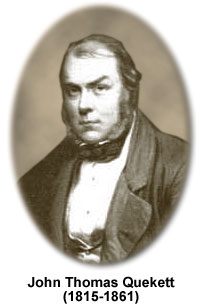John Thomas Quekett
(1815-1861)

Born in England in 1815, John Thomas Quekett was the youngest of four brothers, each with a predilection for natural history. He developed an interest in microscopes early in life and at the age of sixteen built his own microscope with a roasting-jack, parasol, and some fragments of brass. Quekett chose the field of medicine as a career and initially trained with a surgeon in Langport, but then went to London as an apprentice to his brother Edwin. He was accepted as a student at the London Hospital Medical College and at Kings College. In 1840 Quekett won a three-year studentship at the Royal College of Surgeons and specialized in human and comparative anatomy.
Although he was to become a surgeon by profession, Quekett continued to harbor a fondness for microscopes that consumed much of his free time. Inspired by Joseph Jackson Lister's 1830 paper on achromatic microscopes, Quekett and his brother Edwin were among the seventeen founding members of the Microscopical Society of London, now known as the Royal Microscopical Society. As the world's first microscopical organization, formation of the group was of great consequence and has resulted in a significant impact on many fields related to microscopy. They began humbly, however, in 1839 at Edwin's house, Number 50 Wellclose Square in London.
A man of many abilities, Quekett developed a distinguished reputation for his histological pursuits. He was rewarded with a professorship in Histology at the Royal College of Surgeons in 1852 and was a popular lecturer. Two volumes on his histology lectures were published. As conservator of the Hunterian Museum at the college, Quekett produced over 16,000 preparations. Badly damaged during the 1941 bombing of London during World War II, only about 6,000 of the original 65,000 specimens survive, 2,500 of which are from Quekett's collection.
Quekett accomplished much during his short lifetime. He was made honorary secretary of the Microscopical Society in 1841, a position he retained for 18 years, until elected its President from 1860 to his death. In 1848, he wrote a Practical Treatise on the Use of the Microscope, an important work leading to rapid growth in the popularity and scientific potential of microscopy. It was also the first work to address specimen preparation techniques for the newly effective compound microscopes. In 1857, he was made a Fellow of the Linnaean Society, and by 1860, a Fellow of the Royal Society. Quekett wrote a letter in 1861 requesting not to be elected president of the Royal Society because of failing health, but the letter was delayed and he later found himself elected. He held office for only a brief period, however, dying only six months later at the age of 46.
Quekett's efforts in promoting the use of microscopes in modern science became very important as a stepping stone into the world of optics. In 1865 the Quekett Microscopical Club was formed and named in honor of John Quekett for his hard and successful work towards making the microscope a vital scientific research instrument. The group continues as a vital force in the field today, providing amateur microscopists with the opportunity to share the work they love and benefit from each other's experiences.
